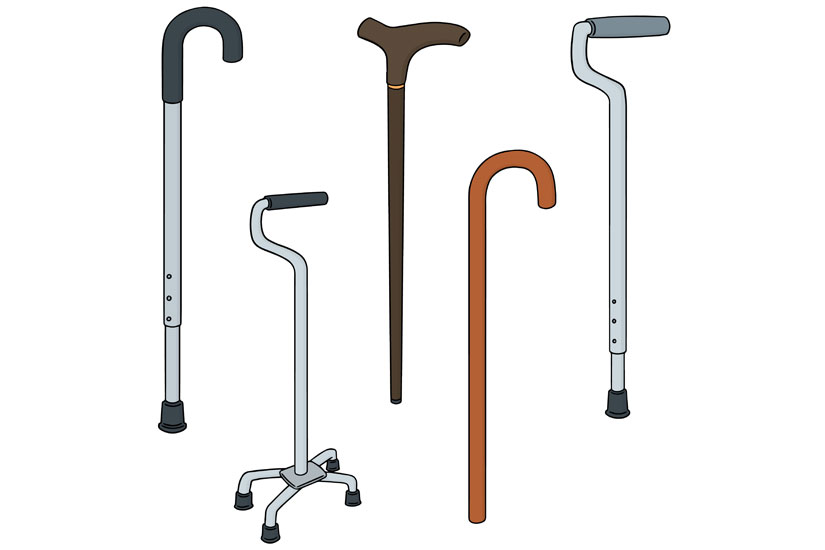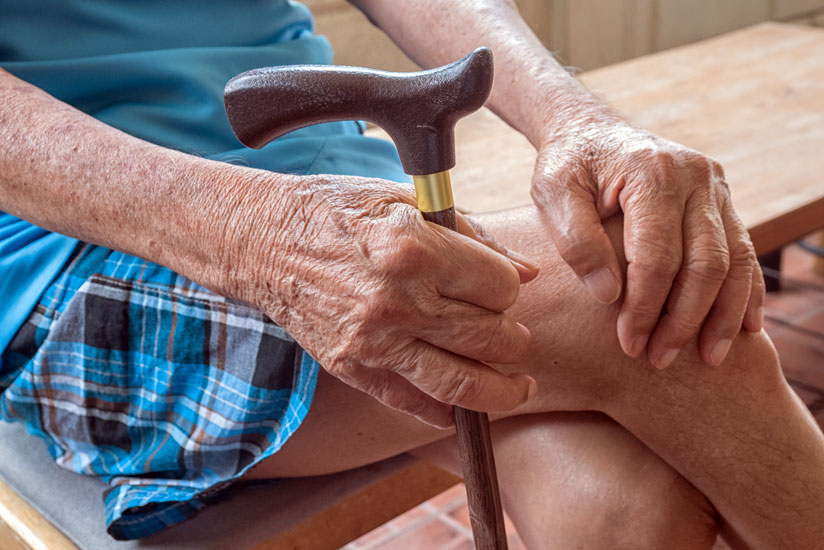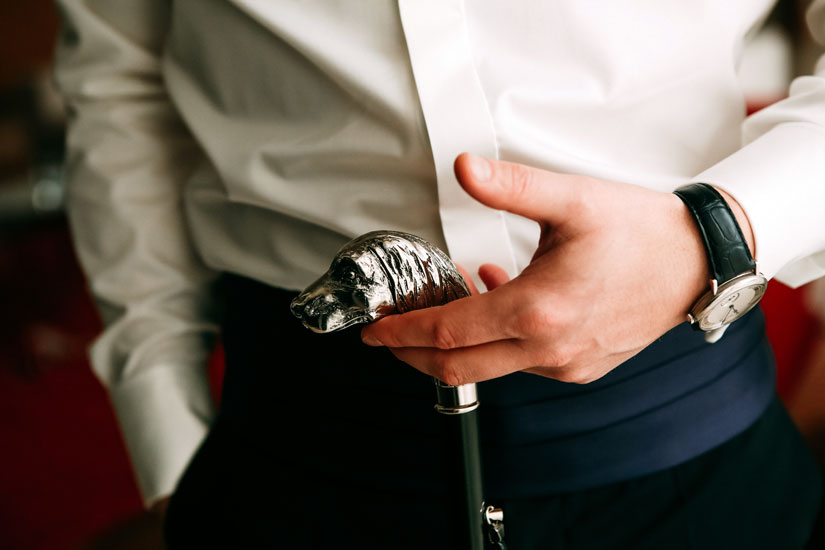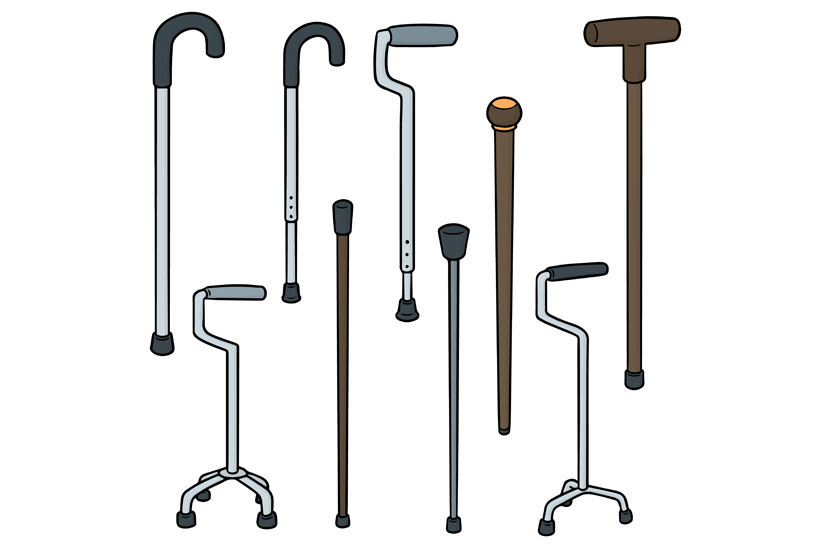If you have sustained a foot, ankle, or leg injury, are recovering from surgery, or suffer from a medical condition that impacts your energy levels, balance, or mobility, using a walking cane can be one of the cheapest and easiest ways to make a difference in your comfort and quality of life!
However, canes are not one-size-fits-all! There are 5 common cane types for elderly users: single-point, multiple-point, forearm, folding, and seat canes. Each type of cane has its own unique benefits and purpose.
Table of Contents
Cane types
Since not all canes are the same, it’s important to figure out which type of cane will work best for your particular needs. It’s always best to check with your physician or physical therapist before selecting and using a cane.
Here’s a look at each of the most common cane types:
Single-point
Single-point or “straight” canes consist of one shaft, one support point at the base, and a handle (handle styles can vary greatly). If you are primarily using a cane to aid with balance, a single-point cane is often a suitable choice.
Multiple-point
Quad and tripod canes fall into this category. These canes have more than one prong at the base and provide the greatest amount of support and stability. Multiple-point canes are usually able to stand upright on their own.
If you need your cane to bear some weight, a quad cane is usually the best option.
Because these canes are heavier and their bases are larger, they can be a bit cumbersome to walk with. You will generally need to walk a bit more slowly and be aware that the wide base could present a tripping hazard.
Forearm
These canes are similar to crutches, though they do not provide as much weight-bearing support as traditional crutches.
Forearm canes feature an arm cuff as well as a support arm for your hand to rest on, distributing impact on the arm more evenly, thus reducing extra strain on the wrist.
Another benefit of this style is that you can have your hand free if need be (to open a door, for example), while the cuff keeps the cane in place.
Folding
Folding canes are straight canes with the added feature of compact, easy storage. Some folding canes are small enough to fit in a handbag! They tend to be very easy to open and close, and typically fold down in a “zigzag” pattern.
Seat
These canes are unique in that they come with their own built-in chair! Seat canes can be folded out (similar to a basic folding chair), giving you a ready-made place to rest if pain, fatigue, or dizziness comes up suddenly.
When the seat is not in use, it stays neatly and compactly folded against the cane shaft.
One important thing to keep in mind, however, is that seat canes do not typically feature a “seat back.”
Types of walking cane handle

The traditional sleek, “crook” shaped cane handle might be the first to come to mind for many of us. But that’s only one of a wide variety of handle styles.
Just as each person’s reason for using a walking cane is a little different, each handle style serves its own specific purpose.
With any cane handle, the chance of strain due to repetitive hand movement is a risk. It’s wise to consult your physician before selecting a cane handle.
Here’s a rundown of the most common cane handle options:
Classic derby handle
Currently one of the more popular styles, Derby handles are designed with support and comfort in mind. They are somewhat straight, with a small “wave” through the palm area.
These handles provide ample support for the user’s wrist, making them a popular choice for arthritis patients.
Another benefit of the Derby style is that the design encourages a user’s weight to center directly over the cane shaft, often resulting in optimal stability.
Ergonomic handle
Ergonomic or “anatomically correct” cane handles are designed to “mold” to the shape of your hand. And they will be specifically made for either the left or the right hand.
These handles encourage even distribution of a user’s weight and aim to put the lowest amount of stress possible on your hands/wrists. These handles sometimes include features such as finger grooves.
Ergonomic handles are often available in stylish colors or designs. So you can add a little-personalized flair!

Fritz handle
Fritz handles are similar to Derby handles, but they are generally a little smaller. These handles have a bit of a curve and are wide enough for even cramped fingers to grab onto, making them good choices for people with arthritis or wrist problems.
The smaller handle style is considered to be a fashionable classic and remains a popular (as well as comfortable) style. Attractive Fritz handles can be found in a number of materials: wood, marble, metal, or Lucite.

J handle/shepherd crook/tourist
This cane style is a well-known classic. There are benefits to this type of handle – it offers a lot of room to grip to find your own best angle. This cane also can be conveniently hung nearly anywhere (or carried on your arm!).
However, “tourist handles” are not the best choice for individuals who need a good deal of support and/or have balance issues. It is also not the most comfortable choice if you have issues with hands, wrists, arms, or upper body strength.
Knob or ball handle
As simple as the name suggests, this type of cane handle features a knob or ball at the top of the shaft. These canes can be quite stylish, but they are rarely a good fit for anyone using a cane for medical reasons.
This type of handle does center all of a user’s weight above the shaft, but it can be tiring to hold onto and provides little in the way of support.
Offset handle
Offset handles are a popular choice these days as they are designed to be comfortable and distribute a user’s weight evenly down the shaft.
These handles somewhat resemble the shape of a question mark and are typically outfitted with a foam grip.
Most quad canes will have an offset handle.

Orthopedic handle
Orthopedic cane handles are somewhat similarly shaped to offset handles, but they are specifically designed to be even more ergonomic. These handles are generally not left or right hand specific, though.
Most frequently, this handle style will be selected at the recommendation of a doctor.
Palm grip handle (L/R)
Palm grips are one of the more unique cane handle designs. These handles feature a wide, flat built-in “cradle” for your palm to rest in. This encourages any pressure and shock to be gently absorbed through the whole arm, versus the hand/wrist taking it on.
The fingers generally don’t have to work as hard with this style of handle, making it yet another great option if you suffer from arthritis.
These handles are made to specifically fit either the left or the right hand – so it’s important to verify which one you are getting!
T handle
T handle canes (sometimes referred to as “straight canes”) are very similar to Derby canes, with the main difference being less curved in the handles.
This style is designed to minimize stress on the hand and wrist of its user.
Custom/Novelty handle
Novelty cane handles can make a bold fashion statement, but they tend to be too uncomfortable for everyday use.
Popular examples of novelty cane handles are animal heads (wolves, birds, snakes, etc.), skulls, and handles carved from animal horns.

Types of cane grips
The “grip” is the part of the cane that you hold onto. Just as handle shape can make all the difference in your comfort, having the right grip is important, too!
You’ll want something that not only provides maximum comfort and minimal strain but also feels nice to the touch (which will, of course, vary due to personal preference).
Grips are not typically sold separately. The cane’s handle can be expected to include one of these grip features when you purchase it:
Foam
These are the most basic grips and what most inexpensive “off-the-rack” canes will have. Foam grips are designed to be comfortable and soft. This cushioning may make foam a good choice for you if your hands are large and/or your grip is heavy.
They are generally also pretty durable but eventually may wear down and require replacement. Fortunately, foam replacement grips are inexpensive and usually pretty easy to switch out.
Gel
Gel cane grips are designed to be extra comfortable and reduce stress on your hand. These may end up being a little too thin to use over long periods of time if you have a heavy grip.
Gel grips are often the most comfortable option for people who have pain or strength issues in their hands.
Orthopedic
Orthopedic cane grips are not usually covered with foam or gel. However, they are designed to effectively work with your body’s musculoskeletal system to provide as much comfort and support as possible.
Orthopedic (or ergonomic) grips come in a variety of shapes. Some styles feature finger grips, while others provide a “shelf” for the wrist to rest upon. This can be an excellent choice for people with arthritis.
Types of cane tips
Canes are also outfitted with a tip at the end. The tip protects the cane shaft from wear, but most importantly, it grips the ground as you walk, adding an extra layer of stability and helping to prevent slipping.
There are a few basic cane tip styles to consider depending on your individual needs:
Rubber
You’ll find most standard canes will have rubber tips. Usually, these are “bell-shaped” and are also reinforced with steel for stability.
Much like the tires on a car, this type of tip will need to be periodically changed. Frequent use will eventually stretch out and wear the rubber down.
Occasionally, a rubber cane tip may tear which can make it dangerous to walk with. It’s a good idea to regularly examine the rubber, and have a replacement tip on hand just in case!
Fortunately, rubber cane tips are inexpensive, and you can buy a pack of 2 or more at a time if you’d like to stock up.
Tripod/Quad
Tripod and quad cane tips are great options to give a standard cane even more stability. In addition to aiding with balance, these cane bases can also support much more weight than their standard counterparts. This makes them an excellent option for those with ankle, foot, or leg injuries.
As their names suggest, a tripod tip is three-pronged, and a quad is four-pronged. These tips are usually made of lightweight aluminum and are often adjustable but do lock into place for safety.
Some of these cane bases are foldable making storage easier.
An important consideration with this tip style is their height. You may need to buy a shorter cane shaft in order to compensate for the difference.
However, tripod and quad canes are often sold as an “all in one” item rather than shaft and base sold separately.
A few more important considerations when considering a tripod or quad-based cane:
Since these bases are much wider than that of a standard cane, it may be impossible to safely navigate staircases or very narrow spaces such as hallways.
These canes are a bit heavier than standard canes. People who become quickly fatigued or who have limited strength in their wrists or upper body may not do well with this style.
These canes do tend to be more costly than standard canes.
QuadPod
QuadPod cane tips are a newer iteration and gaining popularity. They take up less area than a traditional tripod or quad tip, but they don’t sacrifice stability.
Often made of rubber, and therefore also requiring regular replacement, QuadPods are also four-pronged and provide enough stability that the cane could stand upright all on its own.
QuadPods can be a great alternative to traditional tripod/quad styles. They are generally less expensive, lightweight, and do not take up nearly as much space. This could potentially make traversing stairs or other narrow areas feasible for individuals who need a considerable amount of support.
Ice gripper
If you do any walking with your cane over icy terrain or other unstable outdoor surfaces, an ice gripper tip can help you stay safe and stable.
Some standard tips come outfitted with a retractable ice grip that can be popped out with the push of a button when needed.
Alternatively, ice gripper attachments are also available. These attachments are easy to install, very secure, and can be conveniently flipped up and out of the way when not in use.
Ice gripper tips are generally metal-tipped and have between 1 and 5 prongs.

How do you know what size cane to get?
It’s very important to make sure your cane is the right height for you. A too-long cane can be cumbersome to use. And one that’s too short is likely to have you off balance when you walk.
36” is considered “standard” cane size. Most of the time, this length will work just fine if your height is between 68” and 71”.
Other standard length estimates based on height include:
- 35” canes for heights between 64-67”
- 37” canes for heights between 72-75”
- 38” canes for heights between 76-79”
Please keep in mind that those numbers are estimates. Other factors may affect the cane height that you personally will need.
How to measure cane size yourself
- Be sure to do the measurements while you are wearing shoes.
- Stand up as straight as you are able and let your arm hang straight down at your side. In most cases, the arm that will be using the cane is on the opposite side of the injury side. Of course, follow your physician’s advice here.
- Use a tape measure (this will be easier if you have a helper to hold the tape measure!) to find the distance between the floor and the crease in your wrist.
- When you are holding the cane, your hand should only bend about 15 degrees according to Mayo Clinic. (Cane Tips)
- Different factors such as shoulder, arm, hand, and wrist flexibility and strength can affect your cane height needs as well. Ask your physician if there are any extra factors you should be considering.
If you run into difficulties figuring out the measurements–or just want to be certain you’ve got it right–ask your physician to do the measurements in-office.
Another option is to visit a medical supply store where staff members will be trained not only to help with measurements but to also suggest models or features that will work best for your individual body and ailment(s).
In general, it’s always a good idea to consult a medical professional before beginning regular use of mobility aid. According to Medical News Today, only about 20% of users actually receive any training on how to properly use their new equipment. (Mobility Aids)
Related questions
What is the difference between a cane and a walking stick?
A cane is specifically designed to provide support as well as aid in balance. A walking stick, on the other hand, is helpful for balance and navigating difficult terrain, but cannot reliably sustain weight being placed upon it.
What does a white cane with a red tip mean?
A white cane, with or without a red tip, signifies that its user is legally blind. These white canes are typically used to “probe” the user’s path for obstacles rather than used for support.
How much does a walking cane cost?
Standard canes can be as low as $15 without health insurance. Canes with special features can run as high as $80. However, medical insurance will typically cover at least part of the cost if your doctor has prescribed the cane.
References
Aging in Place. “Best Grips for Walkers.” AgingInPlace.com.
https://www.aginginplace.org/best-grips-for-walkers/ (accessed January 22, 2019).
AvaCare Medical. “Canes Buying Guide: How to Choose a Walking Cane.” AvaCareMedical.com.
https://avacaremedical.com/walking-canes-guide (accessed January 22, 2019).
CostHelper Health. “How Much Does a Cane Cost?” Health.CostHelper.com.
https://health.costhelper.com/cane.html (accessed January 22, 2019).
Hugo. “Walking Cane Safety, Part 2: Choosing Walking Canes for Safe Support.” HugoAnywhere.com.
https://hugoanywhere.com/walking-cane-safety-step-2-choosing-walking-canes-for-safe-support/ (accessed January 22, 2019).
Hugo. “Walking Cane Safety Step 3 – Choosing the Safest Grip and Tips for Your Walking Cane.” HugoAnywhere.com
https://hugoanywhere.com/walking-cane-safety-step-3-choosing-the-safest-walking-cane-grip-and-tips/ (accessed January 22, 2019).
Just Walkers. “Tips & Advice Center: Canes.” JustWalkers.com.
https://justwalkers.com/canes-tips/ (accessed January 22, 2019).
Just Walkers. “Using a Cane.” JustWalkers.com.
https://justwalkers.com/using-a-cane/ (accessed January 22, 2019).
Norman, Bill. “Canes Crutches, and Walkers.” MDA.org.
https://www.mda.org/quest/article/canes-crutches-and-walkers (accessed January 22, 2019).
Leonard, Jayne. “Mobility Aids: Types, Benefits, and Use.” MedicalNewsToday.com. https://www.medicalnewstoday.com/articles/318463.php (accessed January 22, 2019).
Mayo Clinic. “Cane Tips.” MayoClinic.org.
https://www.mayoclinic.org/healthy-lifestyle/healthy-aging/multimedia/canes/sls-20077060?s=2 (accessed January 22, 2019).
The Cane Depot. “Walking Canes: Pros and Cons.” Slideshare.net.
https://www.slideshare.net/canedepot/walking-canes-pros-and-cons-39096157 (accessed January 22, 2019).
Sticks, Canes, and Walkers. “5 Top Tips on How to Choose the Best Walking Cane.” SticksCanesAndWalkers.com.
http://stickscanesandwalkers.com/5-top-tips-on-how-to-choose-the-best-walking-cane/ (accessed January 22, 2019).
Sticks, Canes and Walkers. “What is the Difference Between a Walking Stick and Cane?” SticksCanesAndWalkers.com.
http://stickscanesandwalkers.com/what-is-the-difference-between-a-walking-stick-and-cane/ (accessed January 22, 2019).
Sears, Brett, PT. “How to Adjust the Proper Cane Height for Walking.” VeryWellHealth.com.
https://www.verywellhealth.com/how-to-adjust-a-cane-2696292 (accessed January 22, 2019).
American Printing House for the Blind. “What Type of Cane Should I Use?” VisionAware.org.
http://www.visionaware.org/info/everyday-living/essential-skills/an-introduction-to-orientation-and-mobility-skills/what-type-of-cane-should-i-use/1235 (accessed January 22, 2019).
Walking Sticks and Cane. “Orthopedic Walking Canes.” WalkingSticksandCane.com.
https://walkingsticksandcane.com/collections/orthopedic-canes (accessed January 22, 2019).
Well Being Tips. “Cane Handle Types.” WellBeing-Support.com.
https://wellbeing-support.com/cane-handle-types/ (accessed January 22, 2019).
Matsko, Chris M, M.D. “How to Determine the Correct Height of Walking Canes.” WikiHow.com.
https://www.wikihow.com/Determine-the-Correct-Height-of-Walking-Canes (accessed January 22, 2019).
